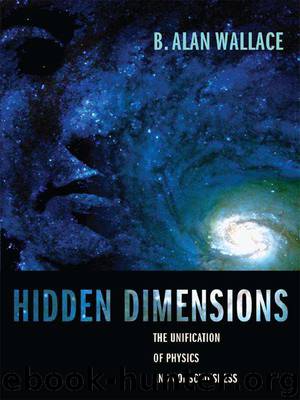Hidden Dimensions: The Unification of Physics and Consciousness (Columbia Series in Science and Religion) by Wallace B. Alan

Author:Wallace, B. Alan [Wallace, B. Alan]
Language: eng
Format: azw3
Tags: Science/Philosophy and Social Aspects
Publisher: Perseus Books Group
Published: 2007-10-08T03:00:00+00:00
The Many Worlds of Ontological Relativity
An essential feature of quantum reality is that it includes the physical world as a whole that does not consist of parts. We can describe this undivided world only if we introduce distinctions in terms of cognitive frames of reference: our world “divides into facts” only because we so divide it.26 While Wheeler and Zeilinger both acknowledge the indispensable role of the observer in quantum mechanics, they also insist that the conscious observation of a measurement does not in any way influence quantum processes.27 As Wheeler maintains, the physical system of measurement has an undeniable role in bringing about an event that makes itself known by an irreversible act of “amplification” from the domain of quantum physics to the world we perceive as real.
This assertion returns us to the question: What demarcates the two objective elements of the system being measured and the system of measurement, and the subjective element of the conscious experimenter? Scientific inquiry since the time of Descartes has been almost universally based on the assumption that an absolute distinction can be made between the experimenter and the system under study. But in light of contemporary physics, such an absolute split is no more justifiable than drawing a demarcation between time and space.28 It is hard to imagine how any explanation of the role of the observer-participant in quantum physics can be complete without including that person’s mind, but most physicists today still believe that any references to the mind lie essentially outside physics and can therefore be safely disregarded. While this does allow one to successfully solve all practical problems of quantum mechanics, it brings one no closer to understanding the nature of the observer.
One physicist who challenges this absolute, Cartesian separation of physics from psychology is Michael Mensky, who presents an ingenious theory that explicitly includes the observer’s consciousness in the theoretical description of quantum measurement. Mensky’s theory is an extension of the so-called “many-worlds interpretation” of quantum mechanics, proposed in 1957 by Hugh Everett in his doctoral thesis, developed under his advisor, John Wheeler.29 Everett called his hypothesis the “relative state interpretation of quantum mechanics,” but ever since Wheeler and De-Witt wrote their papers on this theory,30 it has been known as the many-worlds interpretation. Everett’s paper was long ignored by the scientific community, but over the past twenty years it has attracted growing attention and respect, so that today it is regarded as one of several mainstream interpretations of quantum theory.
According to the most common (Copenhagen) interpretation, the act of quantum measurement entails the “collapse of a wave function,” or a “reduction,” such that among the range of probabilities, one is selected and all the alternatives vanish. But the laws of quantum mechanical systems do not provide for this transition. The so-called “reduction postulate” was introduced into the quantum theory of measurement to describe what is actually observed in the measurements of quantum systems using classical methods. This description artificially imposes classical concepts upon quantum theory so as to allow scientists to make practical calculations.
Download
This site does not store any files on its server. We only index and link to content provided by other sites. Please contact the content providers to delete copyright contents if any and email us, we'll remove relevant links or contents immediately.
The Lost Art of Listening by Michael P. Nichols(7403)
Why I Am Not A Calvinist by Dr. Peter S. Ruckman(4098)
The Rosicrucians by Christopher McIntosh(3465)
Wicca: a guide for the solitary practitioner by Scott Cunningham(3125)
Signature in the Cell: DNA and the Evidence for Intelligent Design by Stephen C. Meyer(3071)
Real Sex by Lauren F. Winner(2966)
The Holy Spirit by Billy Graham(2892)
To Light a Sacred Flame by Silver RavenWolf(2767)
The End of Faith by Sam Harris(2686)
The Gnostic Gospels by Pagels Elaine(2468)
Waking Up by Sam Harris(2389)
Nine Parts of Desire by Geraldine Brooks(2325)
Jesus by Paul Johnson(2309)
Devil, The by Almond Philip C(2279)
The God delusion by Richard Dawkins(2264)
Heavens on Earth by Michael Shermer(2234)
Kundalini by Gopi Krishna(2136)
Chosen by God by R. C. Sproul(2122)
The Nature of Consciousness by Rupert Spira(2044)
